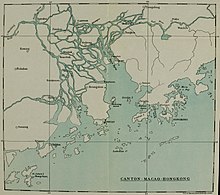
The First Opium War, also known as the Anglo-Chinese War, was a series of military engagements fought between the British Empire and the Qing dynasty of China between 1839 and 1842. The immediate issue was the Chinese enforcement of their ban on the opium trade by seizing private opium stocks from mainly British merchants at Guangzhou and threatening to impose the death penalty for future offenders. Despite the opium ban, the British government supported the merchants' demand for compensation for seized goods, and insisted on the principles of free trade and equal diplomatic recognition with China. Opium was Britain's single most profitable commodity trade of the 19th century. After months of tensions between the two states, the Royal Navy launched an expedition in June 1840, which ultimately defeated the Chinese using technologically superior ships and weapons by August 1842. The British then imposed the Treaty of Nanking, which forced China to increase foreign trade, give compensation, and cede Hong Kong Island to the British. Consequently, the opium trade continued in China. Twentieth-century nationalists considered 1839 the start of a century of humiliation, and many historians consider it the beginning of modern Chinese history.
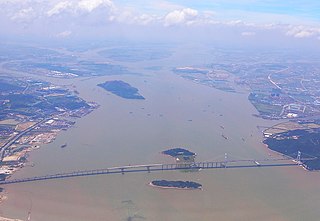
The Pearl River is an extensive river system in southern China. "Pearl River" is often also used as a catch-all for the watersheds of the Pearl tributaries within Guangdong, specifically the Xi ('west'), Bei ('north'), and Dong ('east'). These rivers all ultimately flow into the South China Sea through the Pearl River Delta. Measured from the farthest reaches of the Xi River, the Pearl–Xi–Xun–Qian–Hongshui–Nanpan 2,400 km (1,500 mi) Pearl River system constitutes China's third-longest, after the Yangtze River and the Yellow River, and its second largest by volume, after the Yangtze. The 453,700 km2 (175,200 sq mi) Pearl River Basin drains the majority of Guangdong and Guangxi provinces, as well as parts of Yunnan, Guizhou, Hunan and Jiangxi; it also drains the northernmost parts of Vietnam's Northeast Cao Bằng and Lạng Sơn provinces. The Pearl River is famed as the river that flows through Guangzhou.
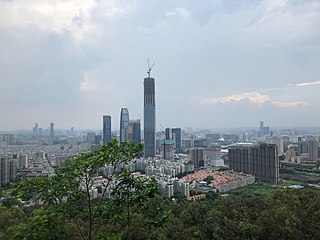
Dongguan is a prefecture-level city in central Guangdong Province, China. An important industrial city in the Pearl River Delta, Dongguan borders the provincial capital of Guangzhou to the north, Huizhou to the northeast, Shenzhen to the south, and the Pearl River to the west. It is part of the Pearl River Delta built-up area with more than 65.57 million inhabitants as of the 2020 census spread over nine municipalities across an area of 19,870 square kilometers (7,670 sq mi).

Humen Town (simplified Chinese: 虎门镇; traditional Chinese: 虎門鎮; pinyin: Hǔmén zhèn; Jyutping: Fu2mun4 zan3), formerly Fumun, is a town in Dongguan city on the eastern side of the Humen strait on the Pearl River Delta, in Guangdong province, China. The former town of Taiping was incorporated into Humen Town in 1985. The population was 838,144 in the 2020 census, making it the second most populous town (zhèn) in China (after Chang'an in Dongguan as well).
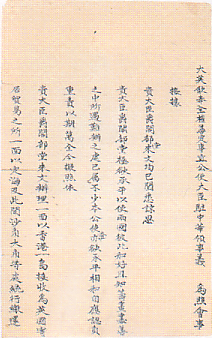
The Convention of Chuenpi was a tentative agreement between British Plenipotentiary Charles Elliot and Chinese Imperial Commissioner Qishan during the First Opium War between the United Kingdom and the Qing dynasty of China. The terms were published on 20 January 1841, but both governments rejected them and dismissed Elliot and Qishan, respectively, from their positions. Foreign Secretary Lord Palmerston stated that Elliot acquired too little while the Daoguang Emperor believed Qishan conceded too much. Palmerston appointed Major-General Henry Pottinger to replace Elliot, while the emperor appointed Yang Fang to replace Qishan, along with Yishan as General-in-Chief of Repressing Rebellion and Longwen as an assistant regional commander. Although the convention was unratified, many of the terms were later included in the Treaty of Nanking (1842).

The Humen Pearl River Bridge (simplified Chinese: 虎门大桥; traditional Chinese: 虎門大橋; pinyin: Hǔmén Dàqiáo; Jyutping: Fu2mun4 Dai6kiu4) is a bridge over the Humen, Pearl River in Guangdong Province, southern China. It consists of two main spans — a suspension bridge section and a segmental concrete section. It connects the Nansha District of Guangzhou to Humen Town of Dongguan. Completed in 1997, the suspension bridge has a main span of 888 meters, and the segmental concrete section's main span of 237 meters is among the longest such spans in the world. It forms part of the G9411 Dongguan–Foshan Expressway. A newer bridge known as Nansha Bridge (Chinese: 南沙大桥), built to reduce the traffic problems on the Humen Bridge, opened to traffic in April 2019.

HMS Wellesley was a 74-gun third rate, named after the Duke of Wellington, and launched in 1815. She captured Karachi for the British, and participated in the First Opium War, which resulted in Britain gaining control of Hong Kong. Thereafter she served primarily as a training ship before gaining the almost surely unwanted distinction of being the last British ship of the line to be sunk by enemy action and the only one to have been sunk by an air-raid.

Pazhou is a subdistrict of Haizhu in southeastern Guangzhou, Guangdong Province, in China.

The First Battle of Chuenpi was a relatively minor naval engagement fought between British and Chinese ships at the entrance of the Humen strait (Bogue), Guangdong province, China, on 3 November 1839 near the beginning of the First Opium War. The battle began when the British frigates HMS Hyacinth and HMS Volage opened fire on Chinese ships they perceived as being hostile.

The Second Battle of Chuenpi was fought between British and Chinese forces in the Pearl River Delta, Guangdong province, China, on 7 January 1841 during the First Opium War. The British launched an amphibious attack at the Humen strait (Bogue), capturing the forts on the islands of Chuenpi and Taikoktow. Subsequent negotiations between British Plenipotentiary Charles Elliot and Chinese Imperial Commissioner Qishan resulted in the Convention of Chuenpi on 20 January. As one of the terms of the agreement, Elliot announced the cession of Hong Kong Island to the British Empire, after which the British took formal possession of the island on 26 January.

The Battle of the Bogue was fought between British and Chinese forces in the Pearl River Delta, Guangdong province, China, on 23–26 February 1841 during the First Opium War. The British launched an amphibious attack at the Humen strait (Bogue), capturing the forts on the islands of Anunghoy and North Wangtong. This allowed the fleet to proceed further up the Pearl River towards the city of Canton (Guangzhou), which they captured the following month.
The Nansha Port Expressway is a truck transportation route in Guangzhou connecting Nansha District to other areas within the Pearl River Delta region. It is 72 km in length and cost ¥6.509 billion RMB.

Guan Tianpei, courtesy name Zhongyin (仲因), art name Zipu (滋圃), was a Chinese admiral of the Qing dynasty who served in the First Opium War. His Chinese title was "Commander-in-Chief of Naval Forces". In 1838, he established courteous relations with British Rear-Admiral Frederick Maitland. Guan fought in the First Battle of Chuenpi (1839), the Second Battle of Chuenpi (1841), and the Battle of the Bogue (1841). The British account described his death in the Anunghoy forts during the Battle of the Bogue on 26 February 1841 as follows:
Among these [Chinese officers], the most distinguished and lamented was poor old Admiral Kwan, whose death excited much sympathy throughout the force; he fell by a bayonet wound in his breast, as he was meeting his enemy at the gate of Anunghoy, yielding up his brave spirit willingly to a soldier's death, when his life could only be preserved with the certainty of degradation. He was altogether a fine specimen of a gallant soldier, unwilling to yield when summoned to surrender because to yield would imply treason.

The Battle of the Bogue was fought between British and Chinese forces at the Humen strait (Bogue), Guangdong province, China, on 12–13 November 1856 during the Second Opium War. The British captured the forts in the Wangtong Islands on 12 November and the forts in Anunghoy Island the next day.

The destruction of opium at Humen began on 3 June 1839, lasted for 23 days, and involved the destruction of 1,000 long tons of illegal opium seized from British traders under the aegis of Lin Zexu, an Imperial Commissioner of Qing China. Conducted on the banks of the Pearl River outside Humen Town, Dongguan, China, the action provided casus belli for Great Britain to declare war on Qing China. What followed is now known as the First Opium War (1839–1842), a conflict that initiated China's opening for trade with foreign nations under a series of treaties with the western powers.

Shiziyang or Shizi Channel is the upper channel of the Pearl River estuary. It runs from the confluence of the Dong River and the Pearl River with parts of the Bei River to the Bocca Tigris which separate Lingdingyang the mid channel of the Pearl River Estuary in the south. It is a wide tidal strait connecting the Huangpu New Port of Guangzhou to the South China Sea.The Huangpu New Port is located at the confluence of the Dong River and the Pearl River. The Huangpu New Port is only part of the larger Port of Guangzhou. Currently there is one rail tunnel and one bridge crossing the Shiziyang.

The Expedition to Canton was a British punitive expedition that captured the forts along the Pearl River, Guangdong province, China, on 2–3 April 1847. Beginning at the Humen Strait (Bogue), the British captured the forts leading up to the city of Canton (Guangzhou). The operation was in response to British subjects being attacked by the Chinese near Canton. Hong Kong Governor John Davis demanded redress from Chinese Commissioner Keying.
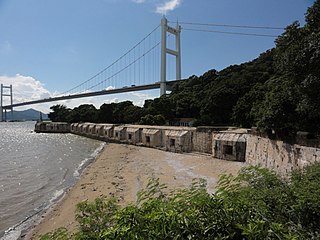
Weiyuan Fort is a coastal-defense fort, now in ruins, in Humen, Dongguan city, Guangdong province, China. The fort was constructed in 1835 and was in use during the Opium Wars. The fort is situated immediately under the Humen Bridge. There were 44 cannons there to defend against the British, 40 dark artillery and four open fort. It is 360 meters in length. Admission is free, with valid documents.
Events from the year 1841 in China.
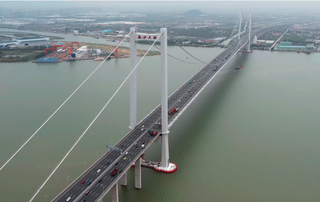
The Nansha Bridge are two suspension bridges located in Guangdong, China, spanning the Pearl River. It is also the beginning of the Guangzhou–Longchuan Expressway. The bridge is an important part of the Pearl River Delta expressway network, connecting the Shatian Town in Dongguan to Nansha District in Guangzhou, as well as the Guangzhou Ring Expressway and the Guangshen Yanjiang Expressway.


